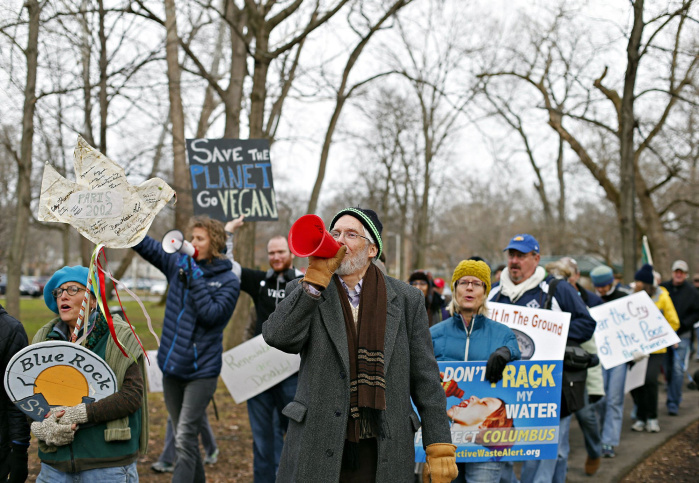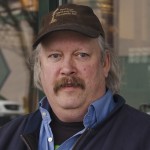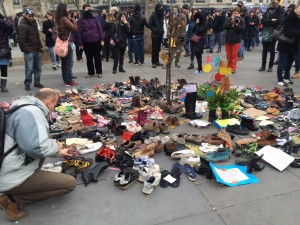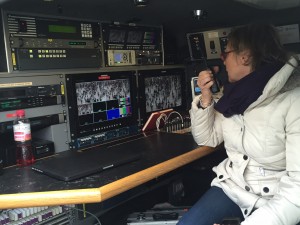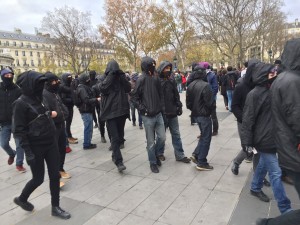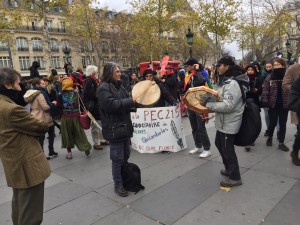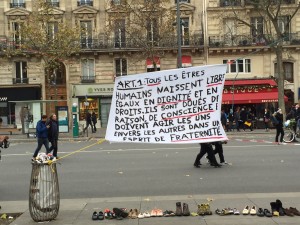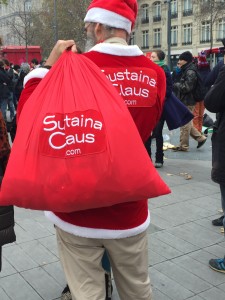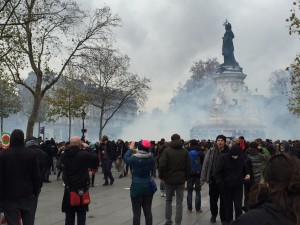Today was a lot calmer than yesterday but no less busy. It was the opening day of the 21st Conference of the Parties to the United Nations Framework Convention on Climate Change, known for short as COP21. Because of all the security measures, Le Bourget, the converted airport north of the Paris city center where COP21 is taking place, was closed to the public. So I went with several members of the Citizens Climate Lobby delegation to the hub for the Climate Action Network, or CAN, a network of organizations from around the world working on climate change. The CAN hub is about a 10-minute walk from my hostel at Place to B, but my phone got confused at an intersection where several streets came together. Eventually I found it, and several of us congregated in two rooms to watch the ceremonies, which were being livestreamed on the Internet.
After the so-called “family photo” of all the visiting world leaders, more than 150 country presidents, prime ministers, and other heads of state were scheduled to speak at the Leaders Event starting at noon. Even though each leader was only given three minutes to speak, there were so many of them that speeches ran in two rooms simultaneously and still went on into the evening.
President Obama spoke about 12:45 and gave what I thought was an excellent speech. He called the Paris climate conference a “turning point … the moment we finally determined we would save our planet.” “I’ve come here personally, as the leader of the world’s largest economy and the second-largest emitter, to say that the United States of America not only recognizes our role in creating this problem, we embrace our responsibility to do something about it,” Obama said. He talked about his recent trip to Alaska and called for an ambitious and transparent agreement. He talked about how this is life or death for island nations and said he was meeting with their leaders tomorrow. He also mentioned the multibillion-dollar investment fund in clean energy research and development to be launched by Bill Gates and others today.
You can see video of Obama’s speech here and read statements by all the world leaders here.
While I was listening to the various leaders speak, I was also paging through my social media accounts and saw that my CCL colleague Chuck Lynd had pulled off quite a march for climate in Columbus. As I was trying to avoid arrest at Place de la Republique in Paris, Chuck and others had gotten over 100 people to come out as part of the Global Climate March organized by 350.org. I was amazed because before I had left, only a handful of people were signed up. In less than a week, Chuck got the word out to environmental advocates across Central Ohio, and they turned out in droves, resulting in a great photo in the Columbus Dispatch. That made my heart sing.
See video of the Columbus march from Carolyn Harding and photos from David Roseman via the Sierra Club Central Ohio Group.
On the frustrating side, the keys on my iPad stopped working. I had planned to live tweet the Leaders Event, and even posted that I would on my Facebook page. but was unable to. This was a cause for some panic, as I had not brought a laptop to Paris but was relying on the iPad to do the heavy lifting. I was worried it had crashed even though it was only six months old. Perhaps the blog posts and photos from yesterday had worked it too hard. I wasn’t sure what to do, so I sent out a query through the CAN-talk listserv asking if anyone had a laptop I could borrow. Most people recommended that I take the iPad to an Apple store in Paris, which I finally decided to do. One was about a mile away, which gave me my first chance to truly walk around the city. Once I got to the Apple store, it took awhile to figure out the system for getting some help, but when I finally did, the technician simply told me to call Apple support. Well, I could have done that from the CAN hub! But unfortunately I did not buy international minutes from Verizon.
Then I noticed that the operating system for the iPad needed to be updated. I prayed that would solve the problem and pressed the button. It was an entire new install of the IOS operating system and took a long time to work. After that, I sat at the store playing with the keys again for awhile. Eventually I decided the iPad was indeed fixed, though I considered buying a new laptop in France anyway. Posting blogs and processing photos is so much easier from a laptop, and I will not travel to an event like this again without one. But not only is the electrical outlet on French laptops different, the keyboard is different — it is not a QWERTY keyboard but AZERTY. So I decided not to.
Finally tonight I ended up at the dinner and meeting for Citizens Climate Lobby. Both took place at apartments that CCL members had rented out for the conference through Air B&B. I’ve never used Air B&B, but after seeing their apartments, I decided to try it next time I am traveling internationally. Their setup looked much more comfortable than the hostel, which is basically a dormitory, and they have access to full kitchens so they can cook their own food. This is cheaper than buying every meal out as I have to do.
The highlight of the CCL meeting was hearing from Joe Robertson, the global strategy director, about the launch today of the Carbon Pricing Leadership Coalition. CCL’s entire platform is carbon pricing, specifically a proposal called carbon fee and dividend that would tax carbon at the source of extraction and return all proceeds to American households. There is a lot of talk nationally about a carbon tax, but a formal discussion of pricing carbon was taken off the agenda for COP 21 in October. Christiana Figueres, executive secretary of the UNFCCC, said at the time that countries had too many different carbon pricing schemes for them to be reconciled into one document.
Even so, the launch of the CPLC on the first day of COP 21 put carbon pricing front and center in the conference. Consisting of 15 national governments (including Canada, Germany, and France), five subnational governments (Quebec, British Columbia, Alberta, Ontario and California), and more than 60 businesses (including BP, Enel, and Shell), the CPLC has a goal of adding carbon pricing to all national strategies by 2020 — only five years away! And they just may be able to do it. At the launch was a powerhouse of leaders: World Bank President Jim Kim, German Chancellor Angela Merkel, Canadian Prime Minister Justin Trudeau, Chilean President Michelle Bachelet, Ethiopian Prime Minister Hailemariam Desalegn, Philippines President Benigno Aquino III, and Mexican President Enrique Peña Nieto. Joe saw the entire thing inside the Blue Zone.
CCL has two blog posts about the launch of the Carbon Pricing Leadership Forum, one by Peter Joseph, leader of the Marin County Chapter, and one by Jessica Langerman, a volunteer from Massachusetts.


